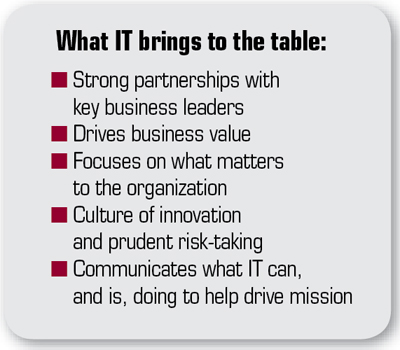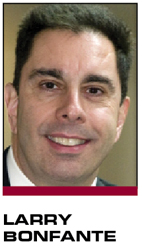There’s a lot of talk these days in the industry about chief information officers wanting a “seat at the table.” They feel, understandably so, that information technology can be a key differentiator in driving business value and that therefore the voice of the CIO should be heard in board and strategy discussions. To me the real question is, How is IT viewed within the organization and what does the CIO bring to the table at which he or she wants the proverbial seat?
I like to play a game I call, “Can you spot the CIO?” If I walked into your board room during a meeting would I be able to quickly pick out the CIO? Many times he/she is the uncomfortable person who feels and looks out of place. He hasn’t taken the time or effort to develop relationships with the other people in the room so he feels like an outsider. A more damning variable is what happens when she opens her mouth? You see, many IT executives don’t speak English. They speak a language I call “geek speak.” Their presentations are filled with TLAs (three-letter acronyms) like VPNs and SLAs, and all this other alphabet soup that means absolutely nothing to their executive management or board members. Many times you feel like you need a translator to decipher what the heck they are talking about. Their focus is often on the “utility” aspect of IT. They are all about accomplishing key metrics of 99.9 percent systems availability or network uptime or some other “critical metric” that is only meaningful to those of us who are IT practitioners.
 |
You see, the real issue is whether the CIO is perceived as a technologist or a business leader, and whether IT is viewed as a utility service or a business enabler.
We have worked very hard to ensure that the investment our organization has made in technology has paid meaningful business dividends. We have developed relationships at a senior level with the key stakeholders in our business. We know, and invest our limited human and financial resources on, what truly matters to our partners in our business units. Our focus is on driving projects that have a tangible business return on investment. This may mean either helping to drive top-line revenue, lowering bottom-line costs, driving operational efficiencies, or engaging our consumers to enhance their tennis experience. Let me give a few examples.
 |
As most of you know, our biggest revenue engine is the U.S. Open. It is an amazing event that brings together the best in sports and entertainment. Over the past few years we have invested in technology to help drive real top-line revenue at the tournament. For example, we implemented an access control solution that allows us to ensure appropriate security of who is allowed on campus during the event. A wonderful side benefit of this functionality is that we now know real time how many
 |
GETTY IMAGES
Innovative use of technology is on display inside and outside on the grounds at the U.S. Open. |
people are on campus at any given time. This has allowed us the flexibility of increasing the number of grounds passes we can sell to our fans, resulting in a significant increase in ticket revenue. A few years ago we blanketed the campus with wireless network connectivity. In addition to improving the experience for our players and media partners, this also allowed us to connect the stand-alone concessions kiosks on the outskirts of the campus. In the past, these kiosks could only take cash tender. Now they can conduct credit and debit card transactions. These one-time capital investments have turned into an eightfold ongoing revenue stream each and every year. That ROI is a metric your board can understand and appreciate.
We also realize that one of the best ways to engage with the people who play in our leagues and tournaments is to provide them a positive online experience. We have invested in a suite of tennis applications that allow our players to manage their tennis experience online. This year we have actually rolled out the first of what will be several mobile applications allowing our players to manage their tennis experience from their iPhones while relaxing over dinner. We are creating a personalized view of a player’s tennis experience so that when he or she logs on to one of our sites they can see all of their latest results, their updated rating, schedule of play, find directions to their next match, and learn about tennis opportunities in their locale. We are leveraging technology to help parents find out everything they need to know to get their kids engaged in playing age-appropriate tennis and giving providers the opportunity to register their programs online so that parents can easily find play opportunities for their kids.
We are leveraging our digital video assets to help our creative team drive more compelling commercials and marketing campaigns while leveraging these assets to drive new revenue through clip licensing. We have revolutionized the media and broadcast experience at the U.S. Open through a solution we call Openvision, which provides our media and broadcast partners real-time access to live streaming of all courts, real-time statistics, live and archived interviews, historical statistics, in short everything they need to support the event from their tablet computer.
The real key to being able to have a strategic dialogue with your key stakeholders is having something to talk about that your leadership values.
Larry Bonfante (bonfante@usta.com) is the chief information officer at the U.S. Tennis Association and author of the soon to be released book “Lessons in IT Transformation: Technology Expert to Business Leader,” published by John Wiley & Sons.







